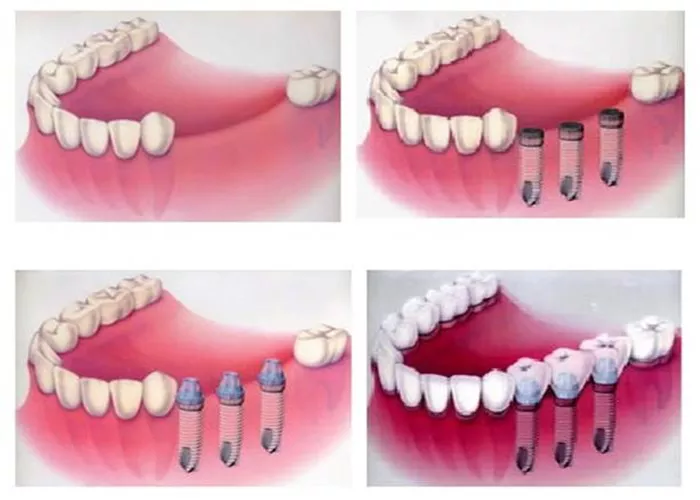Dental implants have become a well – known and increasingly common solution for replacing missing teeth. In the field of dentistry, they have emerged as a significant treatment option over the past few decades. The growth in their popularity can be attributed to various factors, including their effectiveness, aesthetic appeal, and long – term benefits.
Reasons for the Common Use of Dental Implants
Functional Benefits
Dental implants offer a high level of functionality. They are designed to mimic the natural tooth root, providing a stable base for replacement teeth. This stability allows for normal chewing and biting forces to be exerted without the worry of the implant shifting or becoming dislodged. For example, when compared to traditional dentures, which can move around in the mouth during eating, dental implants provide a more natural and efficient chewing experience. This is especially important for patients who have lost one or more teeth and want to maintain their normal diet and oral function.
Aesthetic Advantages
Aesthetics play a crucial role in the popularity of dental implants. The replacement teeth attached to the implants are custom – made to match the color, shape, and size of the patient’s natural teeth. This results in a seamless and natural – looking smile. In contrast to other tooth – replacement options like bridges, which may not always blend in as well, dental implants can enhance the overall appearance of the mouth. Patients are often more confident with their smiles after getting dental implants, which has contributed to their widespread use.
Long – Term Solution
Dental implants are considered a long – term solution for tooth loss. With proper care and maintenance, they can last for many years, if not a lifetime. This is in contrast to some other dental treatments, such as removable dentures, which may need to be replaced or adjusted more frequently. The long – term durability of dental implants makes them an attractive option for patients who are looking for a permanent fix for their missing teeth.
Demographics and Prevalence
Age – Related Prevalence
Dental implants are becoming more common across different age groups. In younger patients, dental implants may be used in cases of accidental tooth loss, such as from sports injuries or trauma. These patients often prefer implants because they offer a more permanent solution and do not interfere with the development of the jawbone in the long – run. Among middle – aged and older patients, tooth loss due to periodontal disease, decay, or natural aging processes is more common. Dental implants are a popular choice for these patients as well, as they can improve both oral function and appearance. For example, in the aging population, dental implants can help prevent the further loss of jawbone density that often occurs with missing teeth.
Geographic and Socioeconomic Factors
The prevalence of dental implants also varies by geographic location and socioeconomic status. In developed countries, where access to advanced dental care is more widespread, dental implants are more commonly used. Higher – income individuals may be more likely to opt for dental implants due to their relatively higher cost compared to other tooth – replacement options. However, with the increasing availability of dental insurance coverage for implants and the overall improvement in dental technology, the use of dental implants is also growing in developing regions and among lower – income groups.
Dental Professionals’ Role in the Common Use of Implants
Training and Expertise
Dentists today are increasingly trained in implant dentistry. Dental schools and continuing education programs offer courses on implant placement and restoration. This has led to a larger number of dentists being able to offer dental implant services. The more dentists who are trained in this area, the more accessible dental implants become to patients. For example, general dentists can now refer patients for implant treatment or even perform some implant procedures themselves, depending on their level of training.
Patient Education
Dental professionals also play a crucial role in educating patients about dental implants. They inform patients about the benefits, risks, and alternatives to implants. Through patient education, dentists can help patients make informed decisions about whether dental implants are the right choice for them. This has contributed to the increased acceptance and use of dental implants. For instance, when patients understand how implants can improve their oral health and quality of life, they are more likely to choose this option.
Future Trends in the Common Use of Dental Implants
Technological Advancements
Ongoing technological advancements are likely to make dental implants even more common in the future. New materials are being developed for implants, which may offer improved biocompatibility and faster osseointegration (the process by which the implant fuses with the bone). Additionally, advances in imaging technology, such as 3D – printed surgical guides, are making implant placement more precise and less invasive. These technological improvements will likely increase the success rate of implant procedures and further boost their popularity.
Expansion of Indications
The indications for dental implants are also expanding. In the past, implants were mainly used for single – tooth replacement or small groups of teeth. Now, they are being considered for more complex cases, such as full – mouth rehabilitation. As the understanding of implant dentistry grows and the techniques improve, more patients with different types of tooth – loss scenarios will be eligible for dental implants.
Conclusion
In conclusion, dental implants have become a common treatment option in dentistry due to their functional benefits, aesthetic advantages, and long – term solutions. Their prevalence is influenced by factors such as demographics, the role of dental professionals, and future technological trends. As the field continues to evolve, it is expected that dental implants will become even more widespread and accessible to patients with missing teeth.
Related topics:

